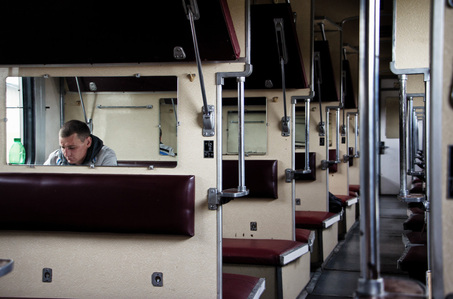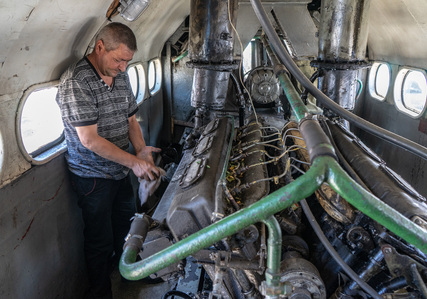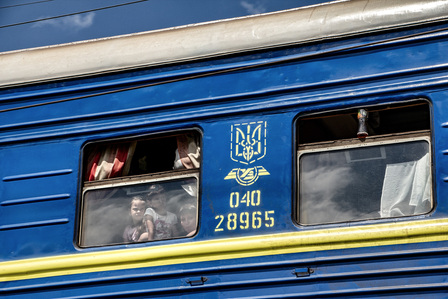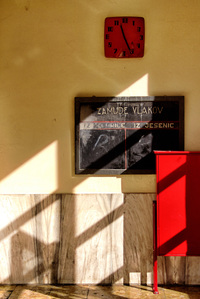ENG
From the coasts of Albania to the mountains of Transcarpathia, a long fil-rouge ties up lives of people in the remote and unspoiled regions of Balkans and Eastern Europe: it’s the railway.
In this part of Europe, trains play a key role for social life, even if infrastructures and rolling stock are mostly old and outdated. In some villages of the Dinaric Alps, of Romanian flatlands or among Bulgarian hills, trains still are the only means of transport and represent the only window on the rest of the world.
Many villages are actually born thanks to trains, and even in the most remote stations passengers constantly get on and off. Thousands of people work in and around trains: here humans run the railway, not computers. The relation between travel time and distance becomes sometimes disproportionate, and passengers feel each kilometre.
Trains in Eastern Europe are fair: there is room for all budgets and travellers, also chickens can get on board. Wagons run among beauty and ugliness, making no distinctions between pristine nature and industrial giants that flow out of the windows. Second hand rolling stock bought at a low price in the Western countries or even traded with raw materials: that’s the roughing backbone of Eastern railways, In the Balkans, each station has hundreds of stories to tell.
This is a 8 years project that brings together pictures taken in 10 countries. The project shows the peculiar everyday life around the local rails, and the most extravagant stories of station masters and passengers, which always run on the slowest, creaky and shaky trains.
ITA
"Pozor Vlak", letteralmente "attenti al treno". Un viaggio per immagini sui binari dell'Europa Centro-orientale.
Nell’era dei voli low cost e dell’alta velocità, le distanze si riducono e i tempi di percorrenza si restringono sempre di più. Ci sono, però, luoghi molto vicini a casa nostra, in cui questo postulato non ha valore: sono i paesi della Penisola balcanica e dell’Europa orientale.
È così che sui treni dell’Est ci si può godere un viaggio vero, non un semplice spostamento. Su questi binari i rapporti tra tempi di percorrenza e distanze si fanno reali, a volte spropositati, i chilometri macinati si sentono uno ad uno sulla propria pelle. Dal finestrino scorrono le stazioni dai nomi misteriosi e altisonanti: Chop, Pàpa, General Todorov, Slavonski Brod; i binari arrivano veramente ovunque, sfidano le pendenze dei Monti Rodopi, nella Bulgaria meridionale, a suon di ponti e curve elicoidali, si inerpicano tra i Carpazi nella Transilvania più profonda, corrono a fianco dei minareti sulle Alpi Dinariche bosniache o disegnano rettilinei infiniti nelle immense pianure della Vojvodina e dell'Ucraina. Chi l'ha detto che esiste solo la Transiberiana?
Treni di seconda e terza mano, scartati dall’Europa che conta, comprati a prezzi stracciati da Romania e Bulgaria, acquisiti come pegno di guerra dopo la Seconda Guerra Mondiale nei paesi dell’ex Jugoslavia, barattati con materie prime e montagne di minerali in Albania; ma anche convogli nuovi e moderni per pendolari, studiati per una “alta velocità” che pian piano si fa strada ma che ad oggi rimane poco più che un’utopia. Ognuno di questi luoghi ha storie da vendere sulle proprie rotaie, storie che ancora oggi si possono assaporare soprattutto sui convogli più lenti e cigolanti, rumorosi e puzzolenti, più scalcagnati e traballanti.

Bumbăta, Moldova

On the train to Basarabeasca. Chișinău, Moldova

Dubrave, Bosnia Herzegovina

Veles, North Macedonia

Oleshnyk, Ucraina

Lukavac, Bosnia Herzegovina

Cărpiniș, Romania

Oskova, Bosnia Herzegovina

The station of Liibrazhd, Albania

Doboj, Bosnia Herzegovina

Night train 341 Chișinău - Moskow, Chișinău, Moldova

Running direction Thessaloniki. Skydra, Greece

The little barber shop inside the station of Oświęcim, Silesia, Poland

Revaca, Moldova

Vynohradiv, Ucraina

Pápa, Hungary

Vore, Albania

Revaca, Moldova

Chișinău, Moldova

Volovets, Ucraina

Line Lovrin-Timișoara, Satu Nou, Western Romania

Revaca, Moldova

Vynohradiv, Ucraina

Avramovo, Bulgaria

Podbordo, Slovenia

Rrogozhine, Albania

Bălți, Moldova

Fălești, Moldova

Train timetable, Radna, Romania

Oskova, Bosnia Herzegovina

Berehove, Ucraina

Ithiman, Bulgaria

Santana, Romania

Lukavac, Bosnia Herzegovina

Berehove, Ucraina